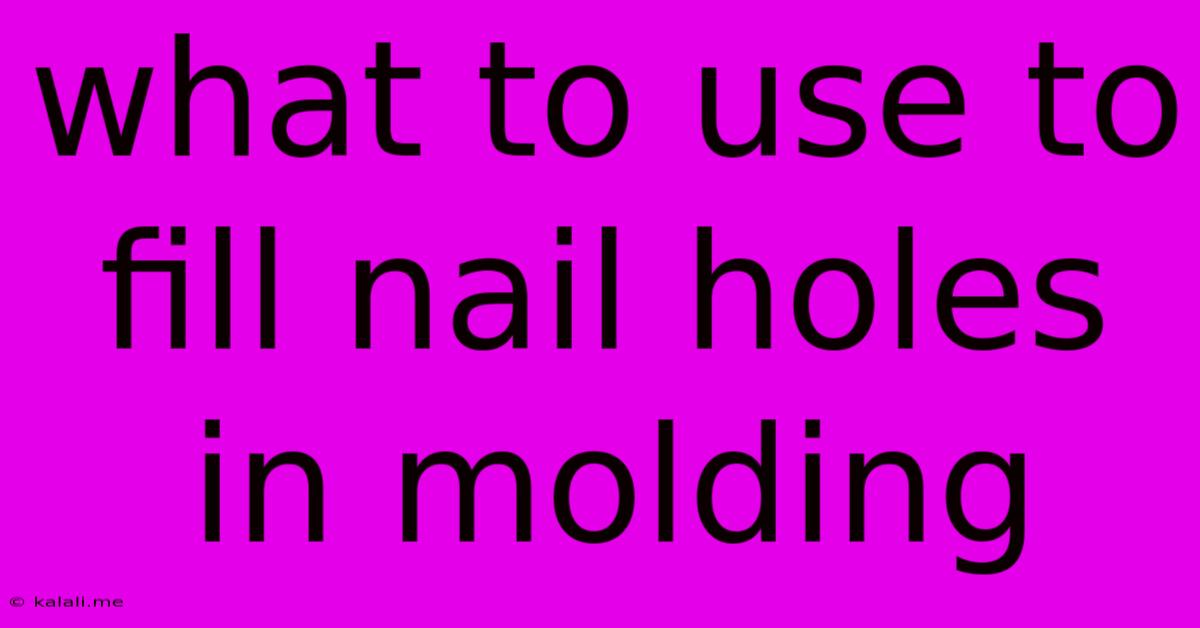What To Use To Fill Nail Holes In Molding
Kalali
May 25, 2025 · 3 min read

Table of Contents
What to Use to Fill Nail Holes in Molding: A Comprehensive Guide
Finding the perfect solution for filling nail holes in your molding can be tricky. Whether you're a seasoned DIYer or a beginner tackling a home improvement project, choosing the right filler ensures a seamless, professional finish. This guide will explore various options, highlighting their pros and cons to help you make the informed decision for your specific needs.
Understanding the Challenge: Why Nail Holes Need Special Attention
Nail holes in molding, especially those made of wood, are more than just cosmetic blemishes. They represent imperfections that can compromise the structural integrity and aesthetic appeal of your home's décor. Choosing the right filler is crucial for achieving a smooth, paintable surface that blends seamlessly with the surrounding molding. The wrong filler can lead to cracking, shrinking, and an unprofessional look.
Top Choices for Filling Nail Holes in Molding
Several materials excel at filling nail holes, each with unique properties:
1. Wood Putty:
- Pros: Easy to apply, readily available, dries quickly, sands smoothly, and readily accepts paint. Comes in various wood tones to match existing molding.
- Cons: Can shrink slightly after drying, may not be suitable for large holes, might require multiple applications for deep holes. Suitable for smaller, less noticeable holes.
2. Spackling Paste:
- Pros: Excellent for smaller holes, dries quickly, sands easily, and is inexpensive. A versatile option readily available at most hardware stores.
- Cons: Can shrink or crack if applied too thickly, may not be as durable as wood putty for larger holes, the finish might not be as smooth. Ideal for minor nail hole repairs.
3. Caulk:
- Pros: Excellent for filling gaps and cracks around molding, creates a flexible and durable seal, readily available in paintable formulas.
- Cons: Not ideal for filling solely nail holes unless they are extremely small and shallow. Can be messy to apply and requires more precise cleanup. Better suited for larger gaps and cracks.
4. Epoxy Putty:
- Pros: Stronger and more durable than wood putty or spackling paste, ideal for larger holes or damaged areas, resists shrinking and cracking.
- Cons: More expensive than other options, requires more precise application, curing time is longer. A great option for more significant repairs or in high-traffic areas.
5. Wood Filler Sticks:
- Pros: Convenient for small holes, quick and easy application, minimal cleanup required.
- Cons: May not be suitable for larger holes, limited color options. A good solution for quick fixes and minor repairs.
Choosing the Right Filler: Factors to Consider
The best filler for your nail holes depends on several factors:
- Size of the hole: Small holes can be easily filled with wood putty, spackling paste, or filler sticks. Larger holes might require epoxy putty or a combination of fillers.
- Type of molding: The material of your molding (wood, plastic, etc.) influences the type of filler that will adhere best.
- Your skill level: Wood putty and spackling paste are easier to use for beginners. Epoxy putty requires more skill and precision.
- Budget: Filler sticks and spackling paste are generally less expensive than epoxy putty.
Application and Finishing Tips
Regardless of the filler you choose, follow these steps for a professional finish:
- Clean the hole: Remove any loose debris or dust from the nail hole.
- Apply the filler: Use a putty knife or similar tool to apply a small amount of filler, slightly overfilling the hole.
- Allow it to dry: Follow the manufacturer's instructions for drying time.
- Sand smooth: Once dry, use fine-grit sandpaper to smooth the filled area until it is flush with the surrounding surface.
- Prime and paint: Apply a primer to ensure the paint adheres properly and to create a uniform surface for painting.
By carefully selecting the appropriate filler and following these steps, you can effectively repair nail holes in your molding, restoring its beauty and extending its lifespan. Remember, attention to detail makes all the difference in achieving a professional, seamless finish.
Latest Posts
Latest Posts
-
What Makes A Pixel More Important In A Cnn
May 25, 2025
-
Does A Pb And J Sandwich Need To Be Refrigerated
May 25, 2025
-
What Does Ot Mean In Texting
May 25, 2025
-
How Long Will Tuna Salad Last In Fridge
May 25, 2025
-
How To Remove A Sheared Screw
May 25, 2025
Related Post
Thank you for visiting our website which covers about What To Use To Fill Nail Holes In Molding . We hope the information provided has been useful to you. Feel free to contact us if you have any questions or need further assistance. See you next time and don't miss to bookmark.